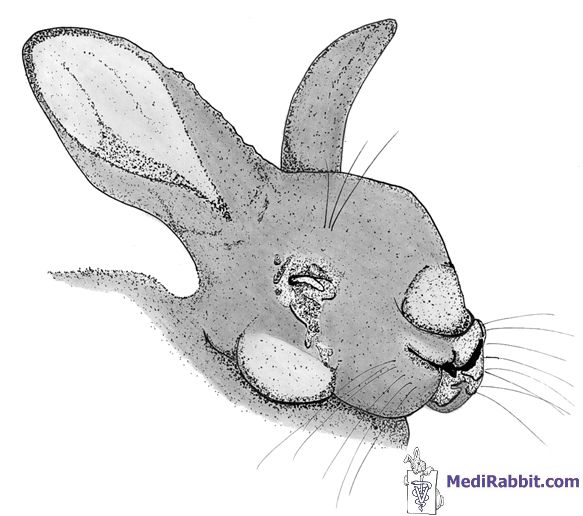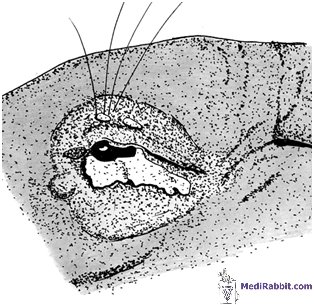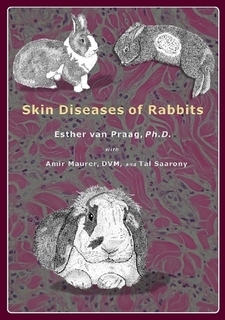Myxomatózis
Esther van Praag, Ph.D. -
Fordította – Monika Ujvideki
MediRabbit.com kizárólag a nagylelkű
adományozók finanszírozzák. Minden adományt, nem számít mekkora az összeg
értékelik és segíteni fogják a folyamatos kutatást
az orvosi ellátást és a nyulak egészségügyét a világ minden tájáról.
Köszönöm
|
Figyelmeztetés: ez a dokumentum olyan képeket
tartalmaz, mely zavaró, felkavaró lehet
Ez a betegség Uruguay-ból származik és Sanarelli fedezte
fel 1896-ban. Hamar kiderült, hogy az Európai üregi nyúl (Oryctolagus
cuniculi) nagyon érzékeny erre a vírusra, mely súlyos bőrtályogokat
okoz a szenvedő állat halála előtt.
A vírus elterjedt az egész amerikai kontinensen és tipikusan jelen van néhány régióban (O. cuniculi
Chilében; Sylvilagus bachmani
az USA nyugati részében). Az 1950-es években a myxomatózis vírust meghonosították és elterjesztették az Ausztráliai vadnyulak között, hogy csökkentsék a szaporulatot. Ez az eljárás majdnem
kipusztította a teljes populációt, csak néhány nyúl élte
túl, mely ellenállónak bizonyult erre a vírusra. A túlélő
nyulak utódnemzésbe kezdtek és hamarosan
újra betelepítették az országot. Európában a vírus gyorsan elszaporodott és jelenléte tipikussá vált néhány régióban.
A lagomorph csoportok, melyek nagyban érintettek a myxoma vírus által: az európai
üregi nyúl (Oryctolagus
cuniculi), az európai
mezei nyúl (Lepus europaeus), a nyugat-amerikai (S. bachmani)
és a kelet-amerikai
üregi nyúl (S. floridanus).
A myxomatózist egy poxvírusokhoz
tartozó vírus okozza. Többféle faj létezik. Néhányuk nagyon virulens (pl.
Standard laboratory, Lausanne, California), mások krónikusan jelennek meg.
Genetikai tanulmányok rokonságot mutatnak ki a myxoma és a Shope fibróma
vírus között (lásd: Tényleg vannak szarvat viselő nyulak? Fibromatózis). A betegséget alapvetően
rovarok terjeszik: bolhák, szúnyogok,
tetvek és atkák. Továbbá úgy
tartják, hogy a betegség egyik nyúlról a másikra bőr és
szőrkontaktus révén terjedhet. Tünetek és diagnózis
A betegség súlyossága a fajok virulenciájától függ. Az
első tünetek már 3 nappal a fertőzés után megjelennek: duzzadt
(ödémás) szemhéjak, melyet az ajkak, a nemi szervek megdagadása és gennyes
kötőhártyagyulladás követ. A betegség későbbi szakaszaiban a nyúl
megvakul.
A myxoma vírus
fertőzést gyakran 8-15 nappal később halál követi. A betegség krónikus formájában a legkiemelkedőbb
jegyek a füleken, orron és végtagokon lévő bőrduzzanatok. Ezek a
duzzanatok, csomók idővel maguktól felszívódnak
A myxomatózis krónikus formájának egy mellékhatása a másodlagos bakteriális fertőzés. Tüdőgyulladás
gyakran megfigyelhető
a Pasteurella sp. vagy
Staphylococcus aureus által. Ezt
dyspnoea (nehézlégzés) kíséri.
DiagnózisA klinikai
tünetek általában elegendőek a diagnózishoz.
Fontos megemlíteni azonban, hogy a Spirochetosis nevű betegség (melyet a Treponema sp. parazita okoz, s mely a nyúl gáttájékát
érinti) korai stádiumában
a myxomatózishoz meglehetősen
hasonló jeleket mutat. Az ezekkel
a betegségekkel járó duzzanatok valóban hasonlóságot mutatnak, így a myxomatózis és a spirochetosis elkülönítő diagnózisát nagy gonddal kell meghatározni. A myxomatózis
továbbá elkülöníthető
olyan felsőlégúti fertőzésektől, mint
pl. a Pasteurellózis. Ez utóbbiban nincs megfigyelhető duzzanat a gáttájékon, ellentétben a myxomatózisos esetekkel.
Ha a myxomatózis
krónikus, vírusok ellenőrzése céljából szövettani vizsgálat javallt. KezelésHa a
nyúl a myxomatózis agresszív formájában érintett, a túlélési esélyei közel
állnak a nullához. Ekkor a beteg állat emberséges eutanáziája ajánlott. Ha
kezelés mellett döntenek, ez hosszú időn át tartó intenzív ápolást
igényel. Fontos, hogy a beteg nyúl meleg környezetben legyen (21-22°C). A
szemeit és a füleit rendszeresen meg kell tisztítani. Annyi folyadékot és
táplálékot kell adni neki, amennyit csak lehetséges, még akkor is, ha a nyúl
magától is elegendő mennyiségű vizet iszik. A bőrön lévő
duzzanatokat sebészetileg távolítják el. Sajnos,
másodlagos komplikációk gyakran előfordulnak. A leggyakoribbak légzőszervi betegségek és tüdőgyulladás
a Pasteurella sp. vagy Staphylococcus
sp. általi másodlagos fertőzés miatt. Habár a
krónikus myxomatózistól szenvedő nyulak többnyire maguktól
meggyógyulnak, antibiotikumok adhatóak a légzőszervi komplikációk
elkerülése céljából. Depending
on the vaccine used and the age or breed of rabbits, vaccinated rabbits may
develop a mild to serious form of the disease. In rare cases, the rabbit must
be put to sleep.
For detailed information on
myxomatosis in rabbits, by E. van Praag, A.
Maurer and T. Saarony, 2010, 408 pages. $85.- Köszönetnyilvánítás
A special thanks to Denise Baart, for
sharing the pictures of her rabbit Bucks. További információ
Best SM, Collins SV, Kerr PJ.
Coevolution of host and virus: cellular localization of virus in myxoma virus
infection of resistant and susceptible European rabbits. Virology. 2000;
277(1):76-91. Boag B. Observations on the
seasonal incidence of myxomatosis and its interactions with helminth parasites
in the European rabbit (Oryctolagus cuniculus). J Wildl Dis. 1988;
24(3):450-5. Boag B, Lello J, Fenton A,
Tompkins DM, Hudson PJ. Patterns of parasite aggregation in the wild European
rabbit (Oryctolagus cuniculus). Int J Parasitol. 2001; 31(13):1421-8. Calvete C, Estrada R,
Villafuerte R, Osacar JJ, Lucientes J. Epidemiology of viral haemorrhagic
disease and myxomatosis in a free-living population of wild rabbits. Vet Rec.
2002; 150(25):776-82. Chapple PJ, Lewis ND.
Myxomatosis and the rabbit flea. Nature. 1965; 207(995):388-9. Chapuis JL, Chantal J, Bijlenga
G. Myxomatosis in the sub-antarctic islands of Kerguelen, without vectors,
thirty years after its introduction. C R Acad Sci III. 1994; 317(2):174-82. Duclos P, Caillet J, Javelot P.
Aerobic bacterial flora of the nasal cavity of rabbits. Ann Rech Vet.
1986; 17(2):185-90. Edmonds JW, Nolan IF, Shepherd
RC, Gocs A. Myxomatosis: the virulence of field strains of myxoma virus in a population of wild rabbits (Oryctolagus
cuniculus L.) with high resistance to myxomatosis.
J Hyg (Lond). 1975; 74(3):417-8. Flowerdew JR, Trout RC, Ross J.
Myxomatosis: population dynamics of rabbits (Oryctolagus cuniculus
Linnaeus, 1758) and ecological effects in the United Kingdom. Rev Sci
Tech. 1992; 11(4):1109-13. Fountain S, Holland MK, Hinds
LA, Janssens PA, Kerr PJ. Interstitial orchitis with impaired steroidogenesis
and spermatogenesis in the testes of rabbits infected with an attenuated
strain of myxoma virus. J Reprod Fertil. 1997; 110(1):161-9. Ghram A, Benzarti M, Amira A,
Amara A. Myxomatosis in Tunisia: seroepidemiological study in the Monastir
region (Tunisia). Arch Inst Pasteur Tunis. 1996; 73(3-4):167-72. Gorski J, Mizak B, Chrobocinska
M. Control of rabbit myxomatosis in Poland. Rev Sci Tech. 1994; 13(3):869-79.
Jiran E, Sladka M, Kunstyr I.
Myxomatosis of rabbits--study of virus modification. Zentralbl Veterinarmed
B. 1970; 17(3):418-28. Joubert L, Tuaillon P, Larbaigt
G. Serologic and allergologic relationship between rabbit myxomatosis and
fibromatosis viruses. Conglutination reaction and homologous and heterologous
hypersensitivity. Bull Acad Vet Fr. 1970; 43(6):259-76. Joubert L, Oudar J, Mouchet J,
Hannoun C. Transmission of myxomatosis by mosquitoes in Camargue. Preeminent
role of Aedes caspius and Anopheles of the maculipennis group.
Bull Acad Vet Fr. 1967; 40(7):315-22. Kerr PJ, Merchant JC, Silvers
L, Hood GM, Robinson AJ. Monitoring the spread of myxoma virus in rabbit Oryctolagus
cuniculus populations on the southern tablelands of New South Wales,
Australia. II. Selection of a strain of virus for release. Epidemiol Infect.
2003; 130(1):123-33. Kerr PJ, Best SM. Myxoma virus
in rabbits. Rev Sci Tech. 1998; 17(1):256-68. Lawton MP. Myxomatosis vaccine.
Vet Rec. 1992; 130(18):407-8. Licon Luna RM. First report of
myxomatosis in Mexico. J Wildl Dis. 2000; 36(3):580-3. Marcato PS, Simoni P.
Ultrastructural researches on rabbit myxomatosis. Lymphnodal lesions. Vet
Pathol. 1977; 14(4):361-7. Marlier D, Mainil J, Linde A,
Vindevogel H. Infectious agents
associated with rabbit pneumonia: isolation of amyxomatous myxoma virus
strains. Vet J. 2000; 159(2):171-8. Merchant JC, Kerr PJ, Simms NG,
Robinson AJ. Monitoring the spread of myxoma virus in rabbit Oryctolagus
cuniculus populations on the southern tablelands of New South Wales,
Australia. I. Natural occurrence of myxomatosis. Epidemiol Infect. 2003;
130(1):113-21. Merchant JC, Kerr PJ, Simms NG,
Hood GM, Pech RP, Robinson AJ. Monitoring the spread of myxoma virus in
rabbit Oryctolagus cuniculus populations on the southern tablelands of
New South Wales, Australia. III. Release, persistence and rate of spread of
an identifiable strain of myxoma virus. Epidemiol Infect. 2003;
130(1):135-47. Nash P, Barrett J, Cao JX,
Hota-Mitchell S, Lalani AS, Everett H, Xu XM, Robichaud J, Hnatiuk S, Ainslie
C, Seet BT, McFadden G. Immunomodulation by viruses: the myxoma virus story.
Immunol Rev. 1999; 168:103-20. Omori M, Banfield WG. Shope
fibroma and rabbit myxoma factories: electron microscopic observations. J
Electron Microsc (Tokyo). 1970; 19(4):381-3. Patterson-Kane J. Study of
localised dermatosis in rabbits caused by myxomatosis. Vet Rec. 2003;
152(10):308. Patton NM, Holmes HT.
Myxomatosis in domestic rabbits in Oregon. J Am Vet Med Assoc. 1977;
171(6):560-2. Regnery DC. The epidemic
potential of Brazilian myxoma virus (Lausanne strain) for three species of
North American cottontails. Am J Epidemiol. 1971; 94(5):514-9. Regnery DC, Miller JH. A myxoma
virus epizootic in a brush rabbit population. J Wildl Dis. 1972; 8(4):327-31.
Robinson AJ, Muller WJ, Braid
AL, Kerr PJ. The effect of buprenorphine on the course of disease in
laboratory rabbits infected with myxoma virus. Lab Anim. 1999; 33(3):252-7. Ross J. Myxomatosis and the
rabbit. Br Vet J. 1972; 128(4):172-6. Ross J, Tittensor AM. The
establishment and spread of myxomatosis and its effect on rabbit populations.
Philos Trans R Soc Lond B Biol Sci. 1986; 314(1167):599-606. Ross J, Sanders MF. The
development of genetic resistance to myxomatosis in wild rabbits in Britain.
J Hyg (Lond). 1984; 92(3):255-61. Ross J, Tittensor AM, Fox AP,
Sanders MF. Myxomatosis in farmland rabbit populations in England and Wales.
Epidemiol Infect. 1989; 103(2):333-57. Ross J, Sanders MF. Changes in
the virulence of myxoma virus strains in Britain. Epidemiol Infect. 1987;
98(1):113-7. Rothschild M. Myxomatosis and
the rabbit flea. Nature. 1965; 207(2):1162-3. Sellers RF. Possible windborne
spread of myxomatosis to England in 1953. Epidemiol Infect. 1987 Feb;98(1):119-25 Shepherd RC. Myxomatosis: the
occurrence of Spilopsyllus cuniculi (Dale) larvae on dead rabbit
kittens. J Hyg (Lond). 1978; 80(3):427-9. Shepherd RC, Edmonds JW.
Myxomatosis: the release and spread of the European rabbit flea Spilopsyllus
cuniculi (Dale) in the Central District of Victoria. J Hyg (Lond). 1979;
83(2):285-94. Sobey WR, Conolly D, Haycockp,
Edmonds JW. Myxomatosis. The effect of age upon survival of wild and domestic
rabbits (Oryctolagus cuniculus) with a degree of genetic resistance
and unselected domestic rabbits infected with myxoma virus. J Hyg (Lond).
1970; 68(1):137-49. Sobey WR, Conolly D.
Myxomatosis: passive immunity in the offspring of immune rabbits (Oryctolagus
cuniculus) infested with fleas (Spilopsyllus cuniculi Dale) and exposed
to myxoma virus. J Hyg (Lond). 1975;
74(1):43-55. Torres JM, Sanchez C, Ramirez MA,
Morales M, Barcena J, Ferrer J, Espuna
E, Pages-Mante A, Sanchez-Vizcaino JM. First
field trial of a transmissible recombinant vaccine against myxomatosis and
rabbit hemorrhagic disease. Vaccine. 2001; 19(31):4536-43. Trout RC, Ross J, Fox AP. Does
myxomatosis still regulate numbers of rabbits (Oryctolagus cuniculus
Linnaeus, 1758) in the United Kingdom? Rev Sci Tech. 1993; 12(1):35-8. Werffeli F. Observations on the
appearance of a clinically atypical manifestation of myxomatosis in wild and
domestic rabbits. Schweiz Arch Tierheilkd. 1967; 109(1):9-16. Williams RT, Dunsmore JD, Parer
I. Evidence for the existence of latent myxoma virus in rabbits (Oryctolaqus
cuniculus (L.)). Nature. 1972; 238(5359):99-101. Wunderwald C, Hoop RK, Not I,
Grest P. Myxomatosis in the rabbit. Schweiz Arch Tierheilkd. 2001;
143(11):555-8 Zuniga MC.
Lessons in D tente or know thy host: The immunomodulatory gene products of
myxoma virus. J Biosci.
2003; 28(3):273-85. |
e-mail: info@medirabbit.com











